The maximum allowable length of a segment for the 10Base5 is 500 meters. Up to 100 nodes can be connected to a segment. That is up to 100 transceivers can be connected. Repeaters are used to connect terminals that are separated from one another beyond the distance specified above, or to connect more than a limited number of nodes. Each repeater has two ports so that it receives signals through one of these ports and sends them through the other port after amplification. An example of the 10Base5 LAN, Up to 1024 nodes can be connected to a LAN expanded by using repeaters.
We’ll be covering the following topics in this tutorial:
5-4-3 Rule
The number of repeaters that can be used is limited. In the case of data communication between terminals, data can be sent through only up to four repeaters. Therefore, maximum five segments can be provided between terminals. Of these five segments, only up to three can be connected to terminals and are called as populated. The other two are link segments. This limitation is called the 5-4-3 rule (five segments, four repeaters and three populated segments). Those segments that are not or cannot be connected to any terminals are called link segments.
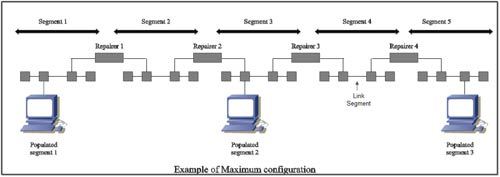
10Base2 Expansion
The maximum allowable length of 10Base2 is 185 meters. Up to 30 can be connected to segment. Repeaters are used as with the 10Base5to connect terminals that are separated from one another by more than the above distance or to connect more nodes than the above limit. The limitations to the number of repeaters that can be used are the same as those for the 10Base5. As with the 10Base5 (5-4-3 rule), up to 1024 nodes can be connected to a LAN expanded by using repeater.
10BaseT Expansion
The maximum allowable length of a cable between a hub and terminal is 100meters in this case. Cascade connection is employed to connect a hub and terminal that are separated from one another by more than the above distance. This connection is also applied when more ports than available are required. The numbers of hubs that can be connected are limited up to four only.
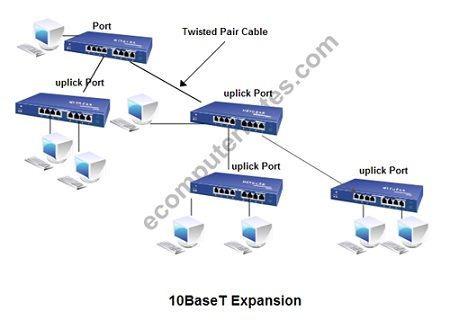
In a cascade connection the hub at downstream from other must have a port to be used exclusively for cascade connection. This port is called an uplink port .Almost all hubs have such a port. However, if the hubs are connected without uplink ports, a special cable, called a cross cable, is used to connect the hub ports.
Hub can be considered a kind of repeater with multiple ports (multiport repeater). This is why the number of repeaters and hubs that can be used is the same.
Stackable Hub
The numbers of hubs are limited to four only for cascade connection. Sometimes, more ports are required. In this case stackable hubs are used. Each stackable hub has a special interface designed to connect it to another stackable hub. Connecting stackable hubs through this interface allows these hubs to be treated as a single hub. This interface is product dependent. The maximum number of stackable hubs that can be connected varies depending upon the product used.
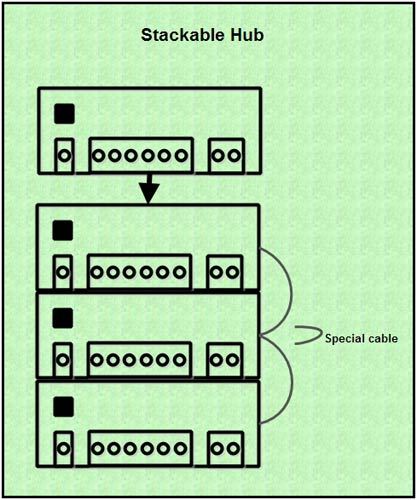
10Base5 +10BaseT
The 10BaseT have become widespread due to its ease of installation and low price. However, because a star type topology is used the 10BaseT is not suitable for a LAN that covers a wide area range. Therefore the 10BaseT is frequently used together with another Ethernet.
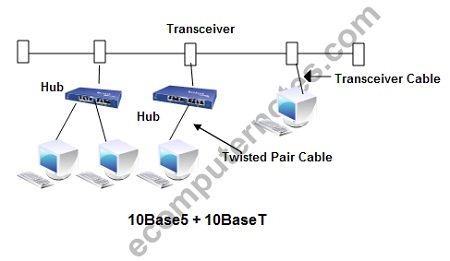
Ethernet Specification
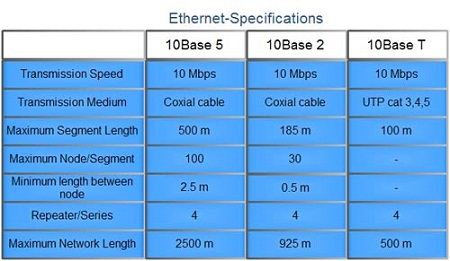
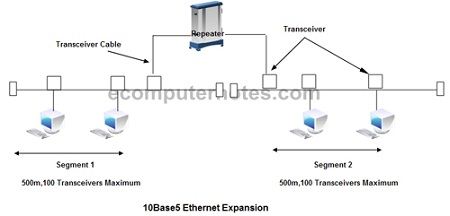
 Dinesh Thakur holds an B.C.A, MCDBA, MCSD certifications. Dinesh authors the hugely popular
Dinesh Thakur holds an B.C.A, MCDBA, MCSD certifications. Dinesh authors the hugely popular